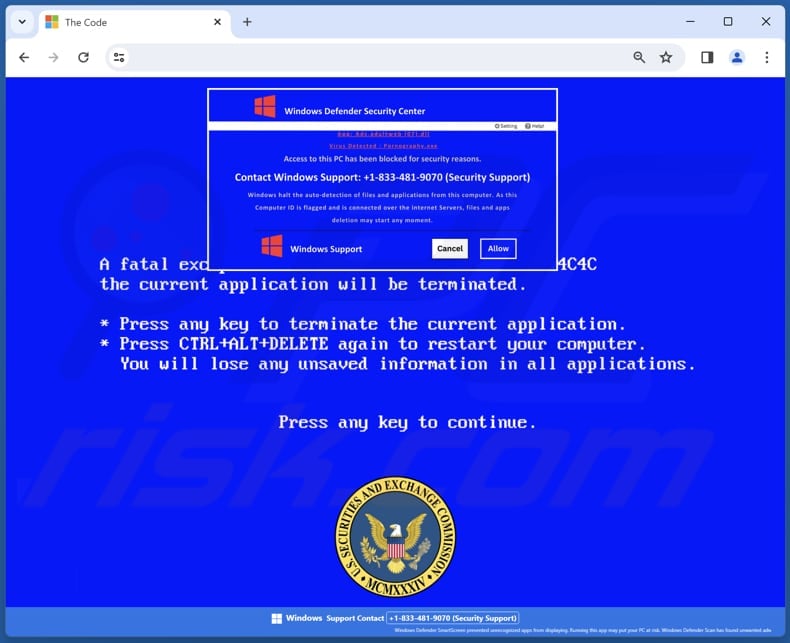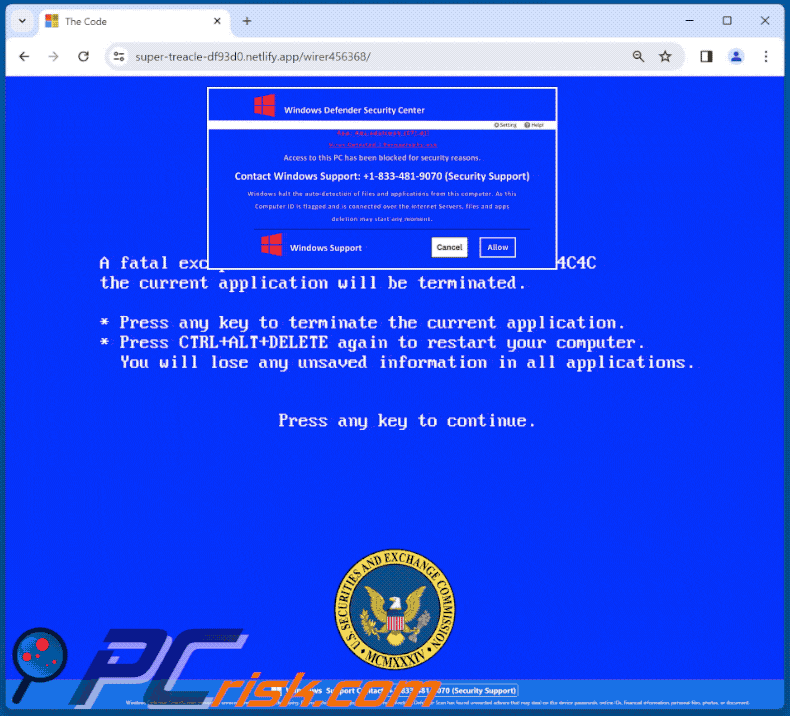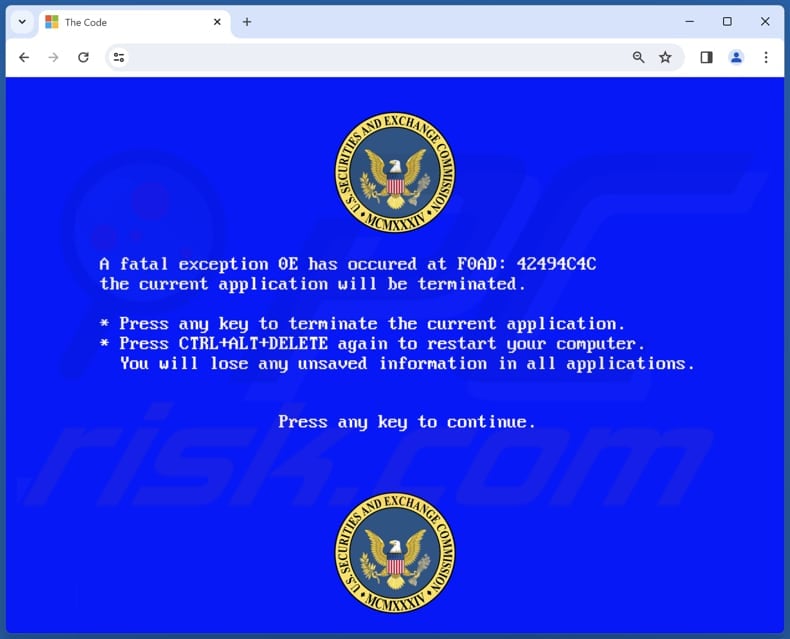How to identify scams like "U.S. Securities And Exchange Commission"
Phishing/ScamAlso Known As: U.S. Securities And Exchange Commission technical support scam
Get free scan and check if your device is infected.
Remove it nowTo use full-featured product, you have to purchase a license for Combo Cleaner. Seven days free trial available. Combo Cleaner is owned and operated by RCS LT, the parent company of PCRisk.com.
What is "U.S. Securities And Exchange Commission"?
After a review, it has been established that this is a classic technical support scam. In this scheme, deceptive pop-ups appear on a fraudulent page with the intention of misleading visitors into taking specific actions. These actions are geared towards coercing users into engaging in activities that benefit scammers.

"U.S. Securities And Exchange Commission" in detail
The displayed message on this technical support scam page mimics a Windows Defender Security Center notification, falsely claiming the detection of a supposed virus named "Pornography.exe". The scam urges users to contact a specified Windows Support number (+1-833-481-9070) under the guise of addressing the security issue.
The message further alleges that access to the user's computer has been blocked for security reasons, creating a sense of urgency. The second message (in the background) introduces a fake system error, stating that a "fatal exception 0E" has occurred with a specific memory address.
It instructs the user to press any key to terminate the current application or use CTRL+ALT+DELETE to restart the computer, warning of potential loss of unsaved information in all applications. Both messages are part of the scam's deceptive tactics, aiming to create a sense of panic and urgency to prompt users to contact the provided number (call scammers).
Threats posed by technical support scams
In these scams, users are typically directed to contact a fraudulent support number, where scammers may pose as legitimate technicians, convincing victims to pay for unnecessary services or products, provide sensitive information, or grant remote access to their systems.
The potential damages include financial loss due to payment for fake services, identity theft if sensitive information is disclosed, and compromised computer security if scammers gain remote access. Additionally, victims may inadvertently install malware or ransomware during the scam, leading to further security risks and potential data loss.
A couple examples of scams where scammers use remote administration tools to lure users into providing access to their computers are TeamViewer and UltraViewer scams.
| Name | U.S. Securities And Exchange Commission technical support scam |
| Threat Type | Phishing, Scam, Social Engineering, Fraud |
| Fake Claim | A computer is infected, access to a computer is blocked, fatal error has occurred |
| Disguise | Warning from Windows Defender Security Center |
| Tech Support Scammer Phone Number | +1-833-481-9070 |
| Symptoms | Fake error messages, fake system warnings, pop-up errors, hoax computer scan. |
| Distribution methods | Compromised websites, rogue online pop-up ads, potentially unwanted applications. |
| Damage | Loss of sensitive private information, monetary loss, identity theft, possible malware infections. |
| Malware Removal (Windows) |
To eliminate possible malware infections, scan your computer with legitimate antivirus software. Our security researchers recommend using Combo Cleaner. Download Combo CleanerTo use full-featured product, you have to purchase a license for Combo Cleaner. 7 days free trial available. Combo Cleaner is owned and operated by RCS LT, the parent company of PCRisk.com. |
Similar scams in general
Technical support scams typically share common characteristics, often employing deceptive pop-ups, alarming messages, or fake system alerts to create a sense of urgency or fear. These scams commonly claim the detection of non-existent computer issues, viruses, or malware, prompting users to contact a provided support number.
The ultimate goal is to trick victims into paying for unnecessary services, divulging sensitive information, or granting remote access to their computers. Examples of technical support scams are "Firewall Update Required", "Threat Service Has Stopped", and "Our Security Scans Have Detected Potential Vulnerabilities".
How did I open a scam website?
Users may find themselves on pages hosting technical support scams through various deceptive methods. Deceptive advertisements, fraudulent emails, and search engine manipulation are common avenues. Additionally, compromised websites and pop-ups can redirect users to scam pages. Social engineering tactics, like fake alerts, also play a role in convincing users to voluntarily visit these pages.
In other cases, users land on fraudulent websites via pages that use rogue advertising networks (e.g., torrent sites and illegal movie streaming pages) or notifications from other unreliable websites.
How to avoid visiting scam pages?
Be cautious when clicking links, especially in emails, messages, or pop-ups. Avoid visiting unfamiliar websites, and check the legitimacy of website URLs before clicking. Use browser features like safe browsing mode and built-in security settings to help identify and block unsafe websites.
Download apps from reliable sources like official pages and app stores, and avoid using alternative channels. Do not trust ads on suspicious websites. Keep your operating system, browsers, and security software up to date. Use a reputable security solution. If your computer is already infected with unwanted apps, we recommend running a scan with Combo Cleaner Antivirus for Windows to automatically eliminate them.
The appearance of "U.S. Securities And Exchange Commission" pop-up scam (GIF):

Text in a pop-up message:
Windows Defender Security Center
App: Ads.adultweb (07).dll
Virus Detected : Pornography.exeAccess to this PC has been blocked for security reasons.
Contact Windows Support: +1-833-481-9070 (Security Support)
Windows halt the auto-detection of files and applications from this computer. As this Computer ID is flagged and is connected over internet Servers, files and apps deletion may start any moment.
Windows Support
Screenshot of the message in the bakcground:

Text in this message:
A fatal exception 0E has occured at F0AD: 42494C4C
the current application will be terminated.* Press any key to terminate the current application.
* Press CTRL+ALT+DELETE again to restart your computer.
You will lose any unsaved information in all applications.
Instant automatic malware removal:
Manual threat removal might be a lengthy and complicated process that requires advanced IT skills. Combo Cleaner is a professional automatic malware removal tool that is recommended to get rid of malware. Download it by clicking the button below:
DOWNLOAD Combo CleanerBy downloading any software listed on this website you agree to our Privacy Policy and Terms of Use. To use full-featured product, you have to purchase a license for Combo Cleaner. 7 days free trial available. Combo Cleaner is owned and operated by RCS LT, the parent company of PCRisk.com.
Quick menu:
- What is U.S. Securities And Exchange Commission technical support scam?
- How to identify a pop-up scam?
- How do pop-up scams work?
- How to remove fake pop-ups?
- How to prevent fake pop-ups?
- What to do if you fell for a pop-up scam?
How to identify a pop-up scam?
Pop-up windows with various fake messages are a common type of lures cybercriminals use. They collect sensitive personal data, trick Internet users into calling fake tech support numbers, subscribe to useless online services, invest in shady cryptocurrency schemes, etc.
While in the majority of cases these pop-ups don't infect users' devices with malware, they can cause direct monetary loss or could result in identity theft.
Cybercriminals strive to create their rogue pop-up windows to look trustworthy, however, scams typically have the following characteristics:
- Spelling mistakes and non-professional images - Closely inspect the information displayed in a pop-up. Spelling mistakes and unprofessional images could be a sign of a scam.
- Sense of urgency - Countdown timer with a couple of minutes on it, asking you to enter your personal information or subscribe to some online service.
- Statements that you won something - If you haven't participated in a lottery, online competition, etc., and you see a pop-up window stating that you won.
- Computer or mobile device scan - A pop-up window that scans your device and informs of detected issues - is undoubtedly a scam; webpages cannot perform such actions.
- Exclusivity - Pop-up windows stating that only you are given secret access to a financial scheme that can quickly make you rich.
Example of a pop-up scam:

How do pop-up scams work?
Cybercriminals and deceptive marketers usually use various advertising networks, search engine poisoning techniques, and shady websites to generate traffic to their pop-ups. Users land on their online lures after clicking on fake download buttons, using a torrent website, or simply clicking on an Internet search engine result.
Based on users' location and device information, they are presented with a scam pop-up. Lures presented in such pop-ups range from get-rich-quick schemes to fake virus scans.
How to remove fake pop-ups?
In most cases, pop-up scams do not infect users' devices with malware. If you encountered a scam pop-up, simply closing it should be enough. In some cases scam, pop-ups may be hard to close; in such cases - close your Internet browser and restart it.
In extremely rare cases, you might need to reset your Internet browser. For this, use our instructions explaining how to reset Internet browser settings.
How to prevent fake pop-ups?
To prevent seeing pop-up scams, you should visit only reputable websites. Torrent, Crack, free online movie streaming, YouTube video download, and other websites of similar reputation commonly redirect Internet users to pop-up scams.
To minimize the risk of encountering pop-up scams, you should keep your Internet browsers up-to-date and use reputable anti-malware application. For this purpose, we recommend Combo Cleaner Antivirus for Windows.
What to do if you fell for a pop-up scam?
This depends on the type of scam that you fell for. Most commonly, pop-up scams try to trick users into sending money, giving away personal information, or giving access to one's device.
- If you sent money to scammers: You should contact your financial institution and explain that you were scammed. If informed promptly, there's a chance to get your money back.
- If you gave away your personal information: You should change your passwords and enable two-factor authentication in all online services that you use. Visit Federal Trade Commission to report identity theft and get personalized recovery steps.
- If you let scammers connect to your device: You should scan your computer with reputable anti-malware (we recommend Combo Cleaner Antivirus for Windows) - cyber criminals could have planted trojans, keyloggers, and other malware, don't use your computer until removing possible threats.
- Help other Internet users: report Internet scams to Federal Trade Commission.
Frequently Asked Questions (FAQ)
What is a pop-up scam?
It is a type of online fraud that involves deceptive pop-up windows or messages designed to trick users into taking certain actions. These pop-ups often appear while browsing websites and convey urgent or alarming messages.
What is the purpose of a pop-up scam?
The primary goal of pop-up scams is to manipulate users into calling the provided number (or clicking a link), leading them to malicious websites, downloading malware, providing remote access to their computers, paying for u
Why do I encounter fake pop-ups?
Pop-up scams typically originate from unreliable websites, and users often do not visit these sites directly. Instead, redirection commonly occurs when users interact with shady ads, notifications from untrustworthy pages, or websites associated with doubtful advertising networks.
Will Combo Cleaner protect me from pop-up scams?
Combo Cleaner is crafted to scan each website you visit, effectively identifying malicious ones, including those set up for pop-up scams. In the event of encountering such sites, immediate warnings will be issued, and access will be restricted.
Share:

Tomas Meskauskas
Expert security researcher, professional malware analyst
I am passionate about computer security and technology. I have an experience of over 10 years working in various companies related to computer technical issue solving and Internet security. I have been working as an author and editor for pcrisk.com since 2010. Follow me on Twitter and LinkedIn to stay informed about the latest online security threats.
PCrisk security portal is brought by a company RCS LT.
Joined forces of security researchers help educate computer users about the latest online security threats. More information about the company RCS LT.
Our malware removal guides are free. However, if you want to support us you can send us a donation.
DonatePCrisk security portal is brought by a company RCS LT.
Joined forces of security researchers help educate computer users about the latest online security threats. More information about the company RCS LT.
Our malware removal guides are free. However, if you want to support us you can send us a donation.
Donate
▼ Show Discussion